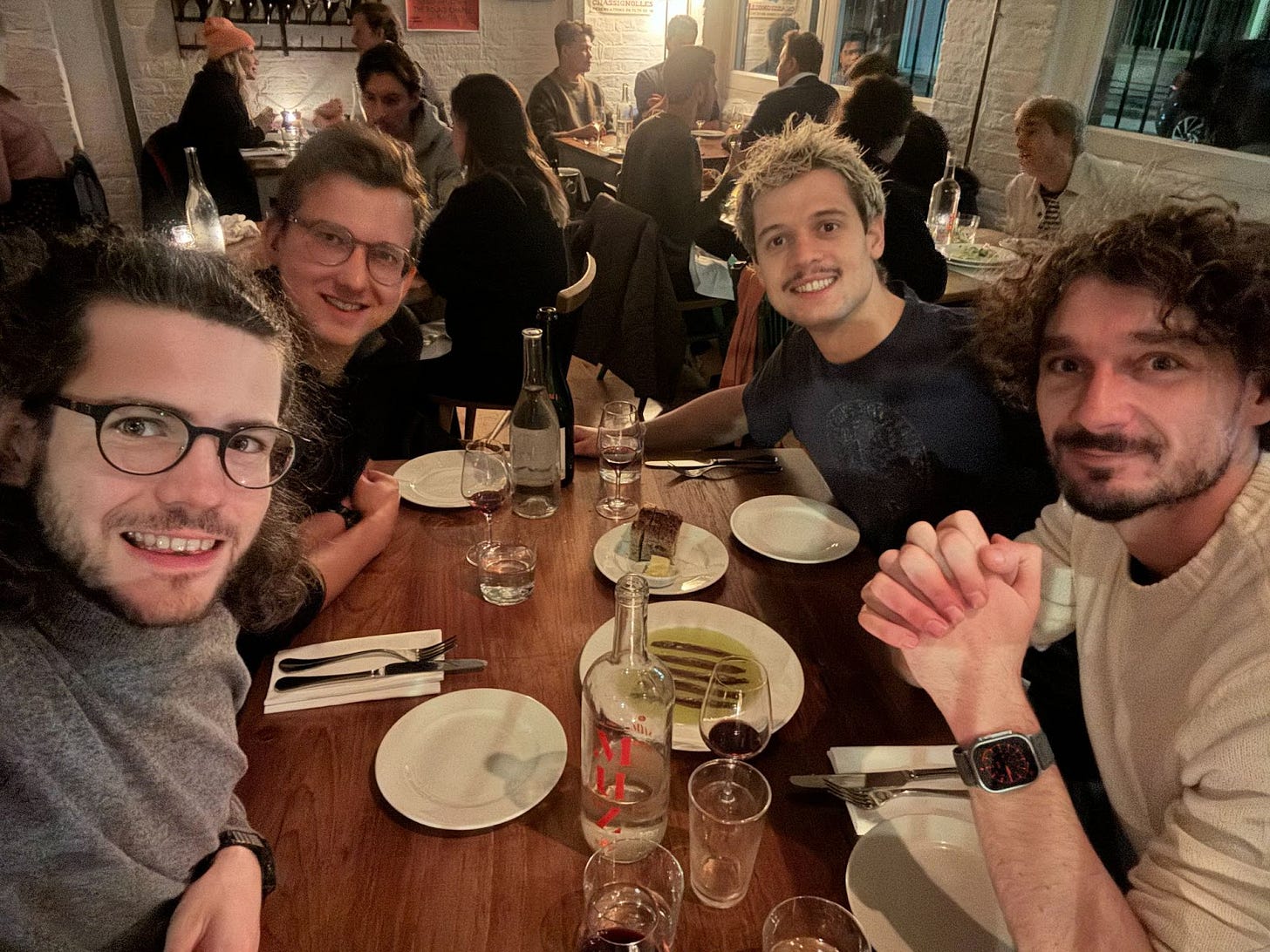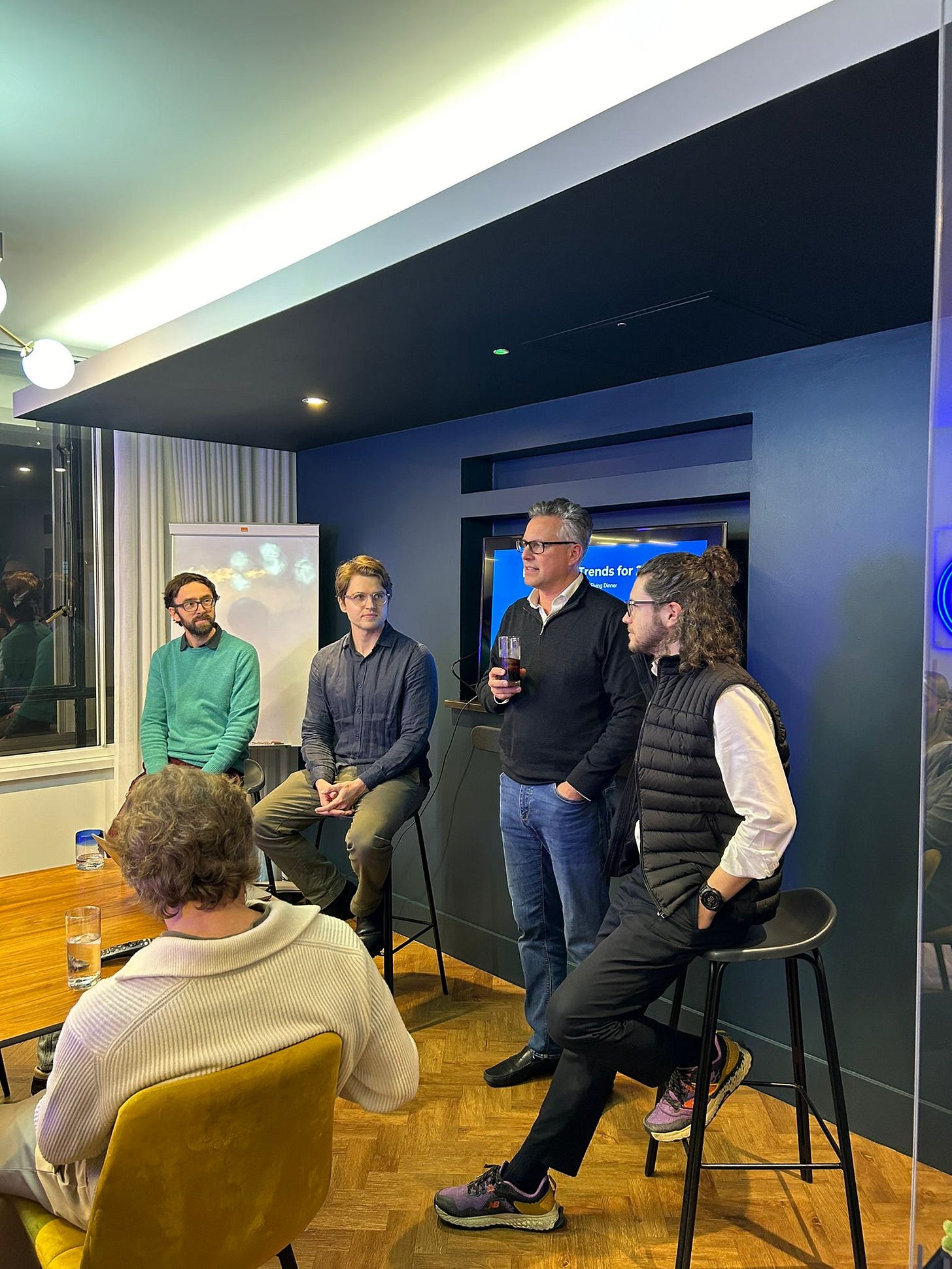Cornerstoned by Isomer Capital, very early Ventures is built to capture the opportunity in three foundational Web3 pillars: Decentralized Infrastructure, Real World Impact, and Public Markets Opportunity.
The very early team has already established a solid initial portfolio in lockstep with leading web3 funds like a16z, Dragonfly, and 1kx. This is evidence that the best founders choose to work with the very early team not just for the capital, but for the value add.
At the core of Web3 lies the possibility of separating money from state. Creating a new global monetary system that transcends borders, redefines property rights, and empowers individuals like never before. This transformation may represent the biggest opportunity of our lifetimes, and we are thrilled to be part of this paradigm shift.
With the speculative excess and hype cleared from much of the Web3 ecosystem, the emerging Web3 bull market appears to be driven by applications that genuinely add value and are built on robust foundations, rather than fleeting fantasies. We believe Web3 is finally reaching the level of maturation we’ve all been waiting for, leading to the founding of projects with tangible benefits and sustainable models instead of mere speculation. And it is these projects that the very early team is helping to bring about.
If you would like an intro to the very early team, don’t hesitate to reach out.
We hope you’ll enjoy this spotlight on very early Ventures and add it to your episodes on Apple or Spotify 🎧
Table of Contents
Executive Summary
Investment Thesis
Why Now Really Is the Right Time
GP Team
Dedication to Community Building
Portfolio
Executive Summary: Investing in the Digital Infrastructure of Tomorrow
very early Ventures stands at the forefront of innovation with a keen focus on three foundational pillars that form its investment thesis: Decentralized Infrastructure, Real World Impact, and Public Markets Opportunity. These pillars are the building blocks of a future where Web3 technologies redefine our digital and physical realities.
Decentralized Infrastructure is likened to the essential utilities of a thriving city, where open and interoperable systems facilitate seamless interactions within the burgeoning Web3 ecosystem. By investing in pioneering protocols and technologies such as Zero-Knowledge proofs and Multi-Party Computation, very early Ventures is laying down the digital roads and establishing the communal marketplaces of tomorrow's on-chain city. Their early-stage investments in this domain are akin to constructing the digital equivalents of highways before the traffic arrives—positioning them at a vantage point as this new world takes shape.
Real World Impact reflects the tangible benefits that Web3 is already delivering across diverse sectors—from finance to art. The fund focuses on actively expanding the reach of Web3 technologies. With every smart contract used in DeFi, with every NFT that redefines ownership, and with every traditional institution that embraces blockchain, they are part of the narrative that is bringing this new technology to the masses.
Public Markets Opportunity takes advantage of the dynamic nature of token valuations and the unique opportunities they present. The valuations of projects that have already launched their token previously have depreciated substantially during the bear market, even if they continued to make strong progress. There are many opportunities with VC-like upside that are traded publicly (sometimes below valuations of previous rounds by leading VCs). The transparent nature of blockchains allows investors to see the details of their traction in a granular way to evaluate these opportunities.
The very early GP team brings to the table a profound blend of technical expertise, industry experience, and a visionary approach to blockchain and cryptocurrency investments. They are not only building a portfolio of innovative companies but are also nurturing a community through education and networking, ensuring that both the team and their LPs are well-informed participants in the Web3 revolution.
LP Education is a testament to very early Ventures' commitment to knowledge sharing, empowering their investors with the insights needed to navigate and contribute to the Web3 landscape. This commitment is exemplified through various initiatives that engage and educate the investor community, fostering a collaborative approach to investment and innovation.
Investment Performance and Portfolio: With strategic investments in companies like Diva, gateway.fm, and Capsule, and co-investing with Web3's leading funds, very early Ventures offers LPs a curated portfolio poised for growth. As we come out of a crypto bear market, the stage is set for the creation of tomorrow's market leaders, and very early Ventures is not just observing but actively laying the foundation for the upcoming bull market. The firm sees blockchain as a solution, an opportunity, and a revolution all rolled into one, ready to be embraced by the world.
Investment Thesis
The investment thesis of very early Ventures is meticulously crafted around three pivotal themes aimed at long-term value generation: Decentralized Infrastructure, Real World Impact, and Public Markets Opportunity. Let’s dive into each 👀
Decentralized Infrastructure is the bedrock of very early Ventures' thesis. It recognizes that composability—the ability of different components of the Web3 ecosystem to interact and integrate seamlessly—is essential for the evolution of the space. However, current infrastructure falls short in supporting the expansive and complex demands of a fully realized Web3 world. Therefore, very early Ventures invests in the development of open and neutral infrastructure that can support a new wave of protocols, capitalizing on network effects and fostering technical innovations such as Zero-Knowledge proofs (ZK), Multi-Party Computation (MPC), and abstraction layers.
Let's break this down with some real-world analogies: Imagine a city. For that city to function smoothly, it needs a variety of infrastructure—roads, bridges, electrical grids, water systems, and more. In the digital world of Web3, "open and neutral infrastructure" refers to the fundamental technologies that allow the digital city—the Web3 ecosystem—to operate. Just as roads are open for all to drive on, this infrastructure is accessible to all, not controlled by any single entity, which helps to ensure fairness and fosters innovation.
Now, you know the concept of "network effects" from almost everything in venture. In our city analogy, you might liken it to a marketplace. The more vendors there are, the more shoppers are attracted, and as more shoppers come, even more vendors want to set up shop. And thus the value of the marketplace grows as more participants join in. In Web3, network effects are central and powerful as they’re central value drivers for the new platforms being introduced to the on-chain city we’re imagining.
An example of decentralized infrastructure are "Zero-Knowledge proofs" (ZKPs), a tool enabling scalability and privacy . Imagine you live in our city and you want to go to a concert and you need to show you're old enough to enter, but you don’t want to reveal your exact age. With a zero-knowledge proof, you could prove you're over the required age limit without disclosing your date of birth. Maybe not that important in this exact situation, but as web3 becomes increasingly important for the validation of transactions and other information without revealing any underlying private data, ZK is central to ensuring high levels of security and privacy.
More general categories of infrastructure that very early Ventures is investing in include:
User Experience (UX): Efforts are being made to simplify blockchain interactions for users. For example, MetaMask, a crypto wallet, allows users to interact with the Ethereum blockchain with an easy-to-use browser extension, removing many of the complexities of managing digital assets.
Cost Reduction: Scalability solutions like Arbitrum provide a framework for building interconnected blockchain networks, which can process transactions more cheaply and quickly than traditional blockchain transactions, making it more feasible for businesses to run microtransaction-based services.
Privacy: While there are benefits to blockchains being entirely transparent, businesses and consumers alike will require privacy if most of their transactions are to eventually happen on-chain. There are many approaches to privacy, of which ZK is just one of many tools.
By investing in these types of Web3 infrastructure, very early Ventures is helping to build the digital roads, marketplaces, privacy tools, shared secrets, and universal translators of the future—creating a world where digital interactions are efficient, secure, and universally accessible.
Real World Impact is the other core theme in the very early thesis and it encompasses all the ways in which Web3 creates tangible effects on traditional sectors. Web3 protocols have already shown their worth in the decentralized finance (DeFi) and non-fungible token (NFT) domains, use-cases that continue to expand rapidly. Large institutions and regulatory bodies are starting to embrace Web3, indicating a broader and more rapid acceptance than previously anticipated. The focus on enhancing user experience (UX) and reducing costs is a strategic move to broaden Web3's appeal and drive mass market adoption. Finance has already established itself as the first major use-case of Web3.
In the “DeFi” (Decentralized Finance) space, platforms like Uniswap and Compound have reimagined lending, borrowing, and trading. They allow users to transact without the need for traditional financial intermediaries like banks, offering greater accessibility and often higher yields on investments. For instance, someone can now lend out their cryptocurrency and earn interest directly through a smart contract, which automates the agreement without a bank in the middle. Uniswap is making 10% of the daily volume of the Nasdaq exchange without any physical branches, large computers, or thousands of employees. Uniswap was built by a small team of engineers, showing the incredible leverage Web3 enables.
Other relevant real-world applications include:
Art: NFTs have revolutionized the way we think about digital ownership and provenance in art. Artists like Beeple have sold digital artwork for millions of dollars, with the blockchain ensuring authenticity and rarity. This is akin to a digital certificate of authenticity for artwork that can be traded or sold on NFT marketplaces like OpenSea.
Fashion: Luxury fashion brands such as Gucci are starting to use NFTs to sell digital versions of their clothing, which can be used in virtual worlds or as a form of digital collectible. This not only opens up new revenue streams but also provides a bridge between physical and digital fashion experiences.
Gaming: Games like "Axie Infinity" have incorporated NFTs to allow players to own unique in-game items and even earn cryptocurrency through gameplay, introducing a new economic model where players can profit from their time and skill in the game.
Institutional Finance: Large financial institutions, such as JPMorgan Chase, have explored blockchain for cross-border payments, reducing transaction times from days to seconds and cutting costs significantly. They've created their own digital coin, JPM Coin, to facilitate instant payment transfers.
Regulatory Bodies: The European Central Bank is exploring a digital Euro, and other central banks are looking into similar concepts, showing that regulatory bodies are not just approving of Web3 technologies but actively engaging with them.
These examples demonstrate the growing impact of Web3 protocols across various sectors, showing that they offer more than just speculative value—they are providing real utility and creating new business models. As user experience continues to improve and costs decrease, we can expect even broader adoption and more innovative applications in the future - and this is what very early taps into with the Real World Impact leg of their thesis.
The "Public Markets Opportunity" pillar of very early Ventures' investment thesis is a crucial part and one which is particular for Web3 investors. So let’s spend a bit more time on what this is and how the dynamics work as this is an important part of understanding the Web3 investment opportunity. It deals with the nuanced world of public token markets and how they differ fundamentally from traditional private equity valuations.
In the public token markets, prices are subject to the sentiments and speculative insights of a global pool of investors, often leading to rapid price movements that reflect the collective mood and expectations. This is described as "reflexivity," a term coined by George Soros, which in this context means that the value of tokens can influence the perceptions of the project, which in turn can affect the value of the tokens in a feedback loop. For instance, a rising token price can signal success, attracting more investors and further pushing up the price, regardless of the underlying fundamentals. And the same happens in a down cycle, the other way around. For this reason, there are exciting projects who have already launched their tokens that have become severely undervalued.
very early Ventures strategically seeks to invest in projects during their early stages, typically when they are undervalued and access to investment opportunities is only restricted by the available liquidity . Investing early in projects with strong fundamentals can lead to substantial returns as the project matures and gains public recognition. The open nature of public blockchain data is another cornerstone of this investment philosophy. Unlike private markets, where information about company performance can be scarce and opaque, the blockchain offers transparency. Metrics such as user traction—how many and how frequently users are interacting with the protocol—and token holder distribution—how tokens are distributed among holders—can be openly accessed and analyzed. This transparency allows very early Ventures to gauge the true performance and potential of a project more accurately and to make informed investment decisions.
Tokens are not just a means of investment; they often play a fundamental role in the functionality of the Web3 protocols themselves. They can be used to incentivize certain behaviors within the network, such as rewarding users for participating in the network's security or enabling governance rights. This utility drives user adoption, as owning tokens is necessary to participate fully in many Web3 ecosystems. The more a token is required for useful activities within its ecosystem, the more intrinsic value it gains, potentially leading to increased demand and price appreciation.
By combining an understanding of the reflexive nature of public markets with the insight provided by blockchain's inherent transparency and the functional utility of tokens, very early Ventures is able to identify and capitalize on opportunities for substantial value creation in the Web3 space.
In essence, very early Ventures' thesis is about recognizing the potential for Web3 to engender substantial changes across various aspects of the economy and society. It's an investment in the infrastructure that will enable Web3 to flourish, and in the applications that will prove its worth. With a clear-eyed view of the present and a visionary outlook on the future, very early Ventures is positioning itself and its partners to be at the forefront of the next wave of digital transformation.
Why Now Really Is the Right Time
The underlying fundamentals of Web3 present a compelling narrative of robust adoption and technological progress. We are only now seeing a shift in public perception from the skepticism of the bear market to more cautious optimism, but far from having caught up with the reality of the tremendous progress that happened over the last few years. This apparent contradiction between sentiment and reality only underscores the strength of the investment case for Web3 today.
Cultural adoption has soared, with traditional institutions like Christie's driving mainstream acceptance through over $100 million in NFT sales, reflecting a burgeoning cultural shift towards digital ownership and art. Similarly, enterprise adoption is evidenced by Siemens' issuance of a $60 million Web3 bond, signifying a deep integration of Web3 protocols into corporate finance and asset management.
The doubling of developer adoption, where tech talents are increasingly pivoting from FAANG companies to Web3 ventures, is a testament to the vibrant and growing ecosystem that is building the infrastructure for the next wave of the internet. These developers are not waiting for a market recovery; they are actively shaping the technology that will fuel the next bull run.
Lastly, the enormous potential for user growth in Web3, as highlighted by the comparison to the early days of the internet, further strengthens the investment case. With a vast majority of internet users yet to engage with Web3, there exists an untapped market of unprecedented scale. The trajectory for growth is not a distant promise but a forthcoming reality, as the infrastructure and applications that cater to these potential users are being developed at an accelerating pace (c.f. the section above section on the real world applications within the very early thesis).
In summary, the current market sentiment around Web3 belies the dynamic undercurrents of adoption and innovation. For discerning investors and stakeholders, the dissonance between perception and fundamentals is not puzzling but rather indicative of a market ripe for investment.
GP Team
The very early GP team stands out through their deep technical expertise and immersion within the Web3 ecosystem. They bring together a remarkable blend of academia, industry experience, and years of dedication to the blockchain industry. Let’s dive into the backgrounds of each and why we think they’re one of the very best Web3 investor teams in Europe right now.
Denis Vuckovac has shown his technical prowess by developing a Bitcoin client in Python. Vuckovac's academic credentials are equally impressive, with a PhD in Machine Learning from ETH Zurich, one of the world's leading technical universities. He has presented at Ethereum’s most important conference, DevCon, and reviewed speaker applications for the Infrastructure track at ETHDenver. Vuckovac's diverse background, with stints at eBay, Bain, Fulbright, and ETH Zurich, allows him to bridge the gap between academia and industry.
Mathieu Chanson has earned his PhD in Distributed Systems, also at ETH Zurich. His paper on Decentralized applications, published in 2016, has garnered over 500 citations. The foresight of his specialization on Ethereum has led to him being sought after by leading Venture Capital firms for technical due diligence. Chanson’s early professional experience includes time at McKinsey before focusing fully on Web3. He has worked as a product manager at leading blockchain projects, including MakerDAO and Celo. Chanson was responsible for the launch of Celo’s liquid staking protocol and instrumental in the project’s transition from a layer 1 blockchain to a layer 2 built on Ethereum.
Jan Baeriswyl, a strategist and innovator whose work in token design has led to the creation of tokens worth billions of dollars. He studied economics and business at the University of St. Gallen. Having led the token design team at Outlier Ventures, Web3's largest accelerator, Baeriswyl has been at the forefront of developing the foundational elements of the Web3 economy. In 2017, Baeriswyl's expertise was recognized at the highest levels of finance and technology, advising the CEO of Barclays and major traditional venture capital firms on Web3. His background features roles at Google, Outlier Ventures, and Earlybird VC.
Together, the very early GP team embodies a rare combination of technical mastery, vision, and practical experience in the Web3 space. Their collective achievements not only underline their individual capabilities but also reflect their potential to drive the very early fund to the forefront of blockchain investments. With such a team, we believe the fund is well-positioned to identify, support, and leverage the next wave of innovations in the ever-evolving Web3 ecosystem.
Dedication to Community Building
The very early GP team has also made significant contributions to the broader Web3 and developer community.
Over the past two years, the team have been featured speakers at some of the most prestigious events in the blockchain world, including Devcon, ethCC, ETH Denver, and ETH Warsaw. Further, understanding the critical importance of education in fostering innovation and adoption within the Web3 space, the team founded an education program specifically targeted at developers in Bosnia & Serbia. This initiative reflects their dedication to empowering the next generation of blockchain developers and their recognition of the transformative potential of education in driving technological progress.
In Zurich, one of Europe’s leading hubs for Web3 Entrepreneurship, the team co-founded Club3, an exclusive community that has quickly grown to over 600 members. Club3's monthly meetups, which regularly attract more than 100 developers, have become a cornerstone of the local Web3 ecosystem, providing a platform for networking, collaboration, and learning. Additionally, the team co-organized the first Ethereum conference in Zurich. These collective efforts by the very early GP team demonstrate their commitment to community building, education, and the advancement of the Web3 ecosystem.
A special focus on LP education
Education is a cornerstone of the value proposition offered by very early Ventures. Their approach goes beyond mere capital investment, fostering a deeper understanding of Web3 among their Limited Partners (LPs).
To facilitate this knowledge transfer, very early Ventures organizes informational sessions, workshops, and networking events that serve as a bridge between LPs and the pioneers of the Web3 world. These events feature founders of Web3 who share insights from their journeys and discuss the frontiers of new developments. At eu.vc we’ve had multiple chances to experience this and have organized two events with the team to broaden the accessibility of Web3 in European venture already. Watch them here 👇
But what we have enjoyed the most is that it’s not just about receiving information; it's about engaging in a dialogue, as was the case at the event they hosted together with Isomer Capital, their cornerstone LP, a few weeks ago:
In essence, very early Ventures is creating an ecosystem that not only invests in the future but also educates its participants about that future, fostering a unique group of forward-thinking investors ready to support and benefit from the next wave of digital innovation.
Portfolio
Now, let’s look at the team’s established portfolio. The easiest thing to spot is probably that the team have made their investments in lockstep with leading Web3 funds such as a16z, Dragonfly, and 1kx proving that the best founders choose to work with the very early team, not just for the capital, but for the value add. Their expertise in Web3 product, token design, and data science are highly appreciated by founders and provide a value add that is hard to replicate.
Diva, gateway.fm, and Capsule stand out as prime examples of the fund's strategic investments, each covered by Web3's premier news outlet, The Block, highlighting the significance and industry recognition of these rounds (read about them here: Diva, Gateway, and Capsule). But let’s take a quick glance at some of them here as well:
Diva provides critical infrastructure for liquid staking, a foundational service in the Web3 ecosystem that allows for greater liquidity and efficiency.
Gateway.fm is pioneering the infrastructure necessary for blockchain interactions, a key component for the seamless integration of blockchain technology into everyday applications.
AlloyX is at the cutting edge of tokenized asset management infrastructure, a sector that is rapidly growing as traditional financial assets become increasingly digitized and moved onto the blockchain. Impossible Cloud and nftfi further illustrate the fund's commitment to real-world impact, targeting enterprise-grade cloud storage and the blue-chip NFT lending market, respectively. These companies are not only advancing technological frontiers but also addressing practical, high-value problems in the market.
Fluidkey is enabling privacy on the Ethereum blockchain and beyond with their stealth-address protocol. Their solution is easy to use and doesn’t require bridging or other complicated setups.
Aethos is allowing applications to comply with regulations without needing to KYC users and while remaining decentralized. They are one of the first protocol to successfully use Eigenlayer, a way of using the economic security of Ethereum (in their case towards ensuring compliance)
Talisman, the multi-chain wallet backed by the fund, with its focus on user experience and portfolio management, demonstrates an acute understanding of the importance of usability in driving mainstream adoption of Web3 technologies.
Meanwhile, Capsule's wallet infrastructure, with SDKs for transaction signing and permissioning, is essential for secure and efficient blockchain transactions, backed by the confidence and capital of industry giants like A16z and Geometry.
By investing in the same rounds as the industry's most respected and successful Web3 funds, the fund offers us as LPs a unique gateway into a vetted, high-potential portfolio providing an optimal blend of risk mitigation and growth potential. This portfolio is not merely a collection of investments; it's a strategic ecosystem of companies that are poised to define the next generation of the internet and digital interaction.
With very early, we don’t merely see ourselves investing in individual companies but rather that we’re buying into a vision of the future—a future where decentralized infrastructure and real-world impact converge to reshape industries and redefine how technology interfaces with society.
Towards an open financial system and a better internet
At the core of Web3’s lies the possibility of separating money from state. Creating a new global monetary system that transcends borders, redefines property rights, and empowers individuals like never before. This transformation represents the biggest opportunity of our lifetimes, and we are thrilled to be part of this paradigm shift.
If you would like an intro to the very early team, don’t hesitate to reach out.
But the potential of blockchain and Web3 goes beyond the financials. We're looking at re-architecting the internet itself, breaking the current centralized monopolies, and putting users back in control of their data, privacy, and digital lives. We hope to enter a new era of a more decentralized, transparent, and accountable digital world.

















